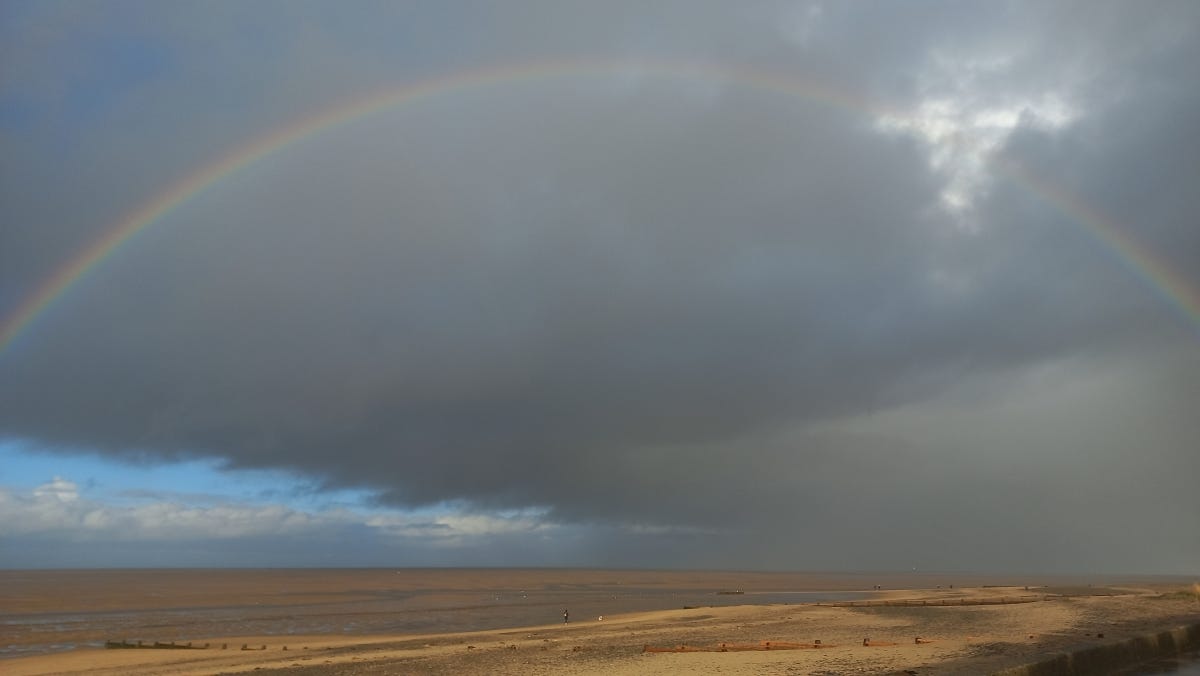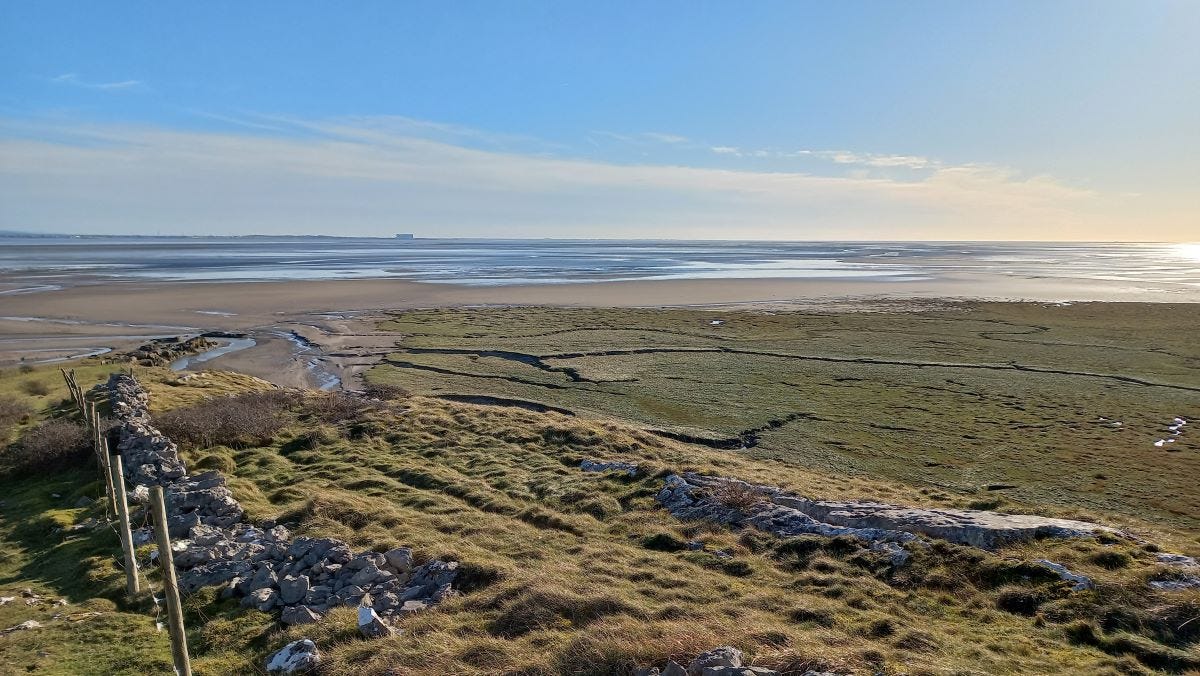Three years ago, I settled on the southernmost edge of Morecambe Bay.
Fleetwood is a small former fishing town that is bounded by the Irish Sea to the west and the River Wyre to the east. On a clear day looking north, the Lakeland Fells dominate the horizon across the bay. Heading south, two roads and a tram line are the only connections with the rest of England. Fleetwood is not a place that people travel through on their way somewhere else.
I fell in love with Fleetwood the moment I stepped onto its silent beach under a starry sky. After a lifetime of wandering, my heart told me that this is the place.
Three years on, I still love walking along the front at Fleetwood and staring out over the expanse of Morecambe Bay. And I’ve visited much of the nearby coastline, too. I have ventured carefully out onto the sands, watched as migrating flocks of oystercatchers come and go with the seasons, and wondered at the movement of the tides.
I have made my home in a place of danger, abundance, impermanence, magic and endless stories.
Shifting sands
Walking where sea, sky and land meet can be treacherous. Sinking sands are common here. Even close to shore, the waterlogged flats give way under my weight. Fleetwood’s promenade is dotted with signs warning people not to follow the tide, and the lifeboat station is on constant alert to rescue anyone unfortunate enough to be stranded by the sea.
Rising and falling by ten metres, the tidal range in Morecambe Bay is one of the largest in the world. More remarkable is the sheer expanse of land that is uncovered as the waters recede. Three hundred square kilometres of intertidal silt and salt marsh are a haven for seabirds who feast on cockles and worms. The view from the beach changes hour by hour.
The more-than-human world here is rich and abundant but largely hidden from human eyes. Beneath the surface of the constantly moving water, sharks breed in the Lune Deep, the channel that carves a canyon through the floor of the bay. Glistening silver smelt, with their distinctive cucumber aroma, swim in shoals. Dolphins and seals can sometimes be glimpsed as they break the waves.
Morecambe Bay sparkles on sunny days and glowers grey as storms stir up the seabed. At low tide, the distant waves are silent; as high tide approaches, the incoming waters roar over the sand towards the shore. West winds in winter whip sand, making it painful to walk into the storm. When cloud descends and fog rolls in, the view disappears behind a veil.
And twice a day, a new landscape emerges from beneath the waves.
Tidal forces
Living on the western fringe of Europe, it’s easy to imagine the rest of the world experiences tides like ours. But on many of our planet’s coastlines, the sea is a constant, barely shifting presence. Tiny tides nudge against Mediterranean shores, and much of the South Pacific moves so slowly that its rise and fall is barely perceptible.
Gravity and the rotation of the planet combine to create a predictable rhythm in the North Atlantic. It takes twelve and a half hours for the sea to rise from its lowest point to its highest and then ebb away again. Just out of sync with the turning of the earth, the twice-daily tide follows the pull of the moon.
Navigating the resulting tides and currents has never been easy. In ancient times, sailors who travelled the Atlantic coasts steered a line that kept them in sight of land but far enough out to avoid submerged dangers. Wherever they safely landed the boats, they brought their culture to shore, etching themselves into the landscape from the hillforts of Galicia to the standing stones of Ireland.
The culture of Europe’s wild edge was shaped by the tides. In summer, the warming sea was a source of abundant food; in winter, proximity to the waves was perilous. So people retreated as storms approached, building stone circles inland as gathering points; henges were sites of midwinter feasting, not midsummer celebration. Life happened on the beach.
Magical realms
The sea resists permanent monuments, but it holds stories.
In old Irish cosmology, the universe was divided into three realms: the land, the sea and the sky. Rising tides and rapidly changing weather meant that the realms’ borders were constantly renegotiated, and perhaps this instilled an acute awareness of the tripartite nature of the world. The Celtic universe was not a simply binary division of heaven and earth, above and below, sacred and profane, this life and the hereafter. Instead, a third realm - the sea - surrounded and suffused every moment. The peoples of these islands lived in a cosmos that held a perpetual three-way negotiation.
Of the three realms, the deep is the resting place of the ancestors, watched over by the god Manannán mac Lir, who rules the Irish Sea from his stronghold on the Isle of Man. A fierce warrior and guardian of the otherworld, he wraps himself in mists, rides across the waves, and carries a bag full of treasures. Unpredictable, generous, cruel and capricious, he embodies the watery world he inhabits.
The old stories are fading now, but the three realms persist. I sense their presence as I step onto the sand at low tide.
Foreshore ritual
The foreshore, lying between the high and low water marks, is a powerful place for ritual.
For a short while, twice each day, the sky reaches down to touch the wide spaces of the earth. The land I walk on will soon be submerged beneath the waves. Here, rigidity can dissolve. Change can flood in.
I search the beach for gifts from the infinite ocean - stones, shells and driftwood - to repurpose as magical tools. I make marks in the sand, draw a labyrinth, and construct a monument.
I speak my intentions into the space between worlds and make offerings to the incoming tide. I whisper the words of the 8th-century Irish poet Blathmac, muir mas, nem nglas, talam cé, acknowledging the powers of the beautiful sea, the blue-grey sky, and the present earth.
The wild edge is a place to let go of my everyday concerns, to listen to the conversation that shapes the cosmos. I become still as wild geese carry my longing on their wings.
I close the circle and retreat to firmer ground. The path I have walked will soon be gone forever. The waves will sweep away everything I thought so solid and certain. But perhaps the retreating tide will reveal a new trail across the drying sand.
Endless stories
I am so fortunate to have the expanse of Fleetwood’s beach just moments from my doorstep. But still, I only get a glimpse of Morecambe Bay. There are so many enchanting, transcendent places to explore in almost two hundred kilometres of coastline.
Windswept Walney Island, with its lonely lighthouse and open sky, a nesting ground for eider ducks. Humphrey Head, the place where England’s last wolf died, hunted over limestone cliffs towards a maze of channels and rock pools. Sunderland Point, the tiny village cut off twice daily by the rising tide.
For too much of my life, I rushed past places like these on my way to tourist destinations that seemed more remarkable, more photogenic, and more comfortable. But I have discovered the deep magic of returning again and again to the lonely, empty, wild edge.
Wherever the wind blows, and rain falls, wherever waves crash, and tides recede, wherever the land, sea and sky meet, the universe longs to tell me its story.
I need only become still enough to listen.










Reading this the day after I walked along the Dyfi estuary, feeling the shifting sand, knowing that later it would be covered again. I picked up a cockle shell, I remembered that they were symbols of pilgrimage. This is what this was a pilgrimage to where the land meets the sky, the sky meets the sea and the sea meets the land. Thank you for your writings I followed the link on Druid Hearth and now am reading through the archive.
So beautiful Dru, I love the ancient Celtic wisdom of the three realms, sea, sky and land, it's so much richer than the binary of earth and heaven. Thanks for taking us to the beach with you.